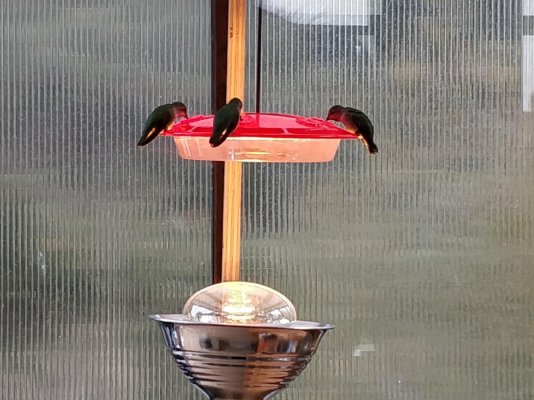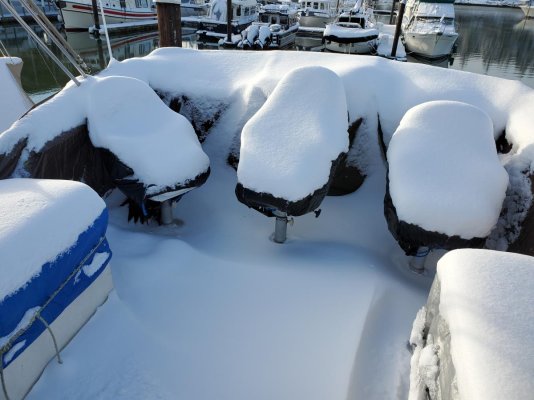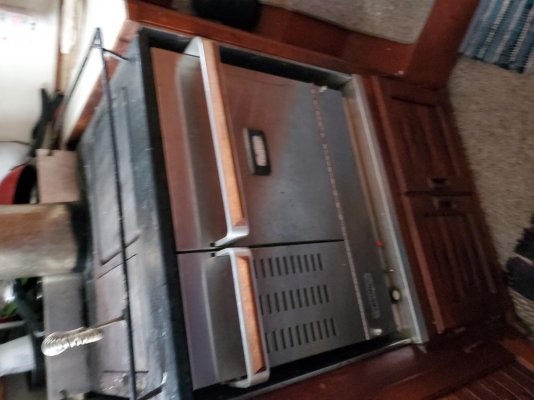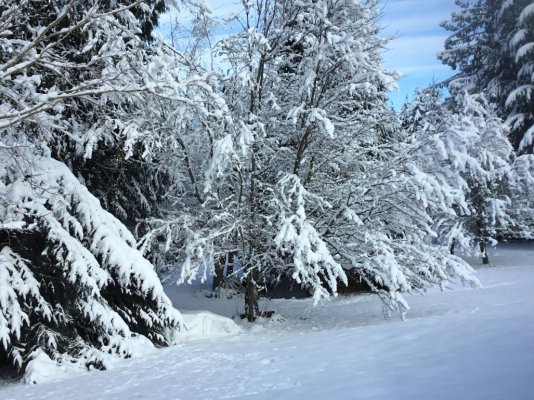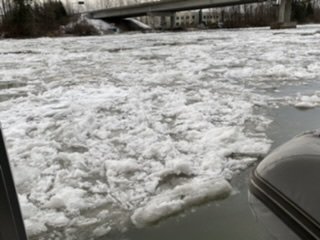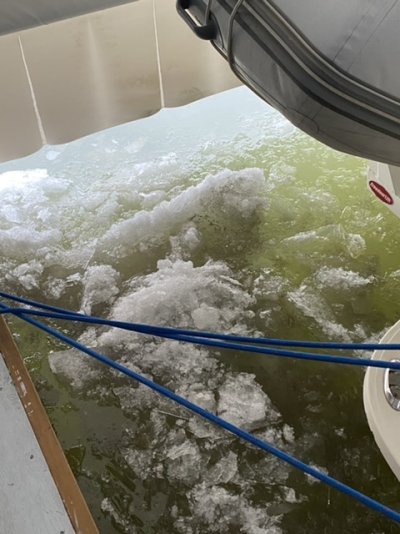You are using an out of date browser. It may not display this or other websites correctly.
You should upgrade or use an alternative browser.
You should upgrade or use an alternative browser.
Cold weather in the NW
- Thread starter monti
- Start date
The friendliest place on the web for anyone who enjoys boating.
If you have answers, please help by responding to the unanswered posts.
If you have answers, please help by responding to the unanswered posts.
magna 6882
Guru
- Joined
- Apr 20, 2020
- Messages
- 720
- Location
- USA
- Vessel Name
- Intrepid
- Vessel Make
- North Pacific/ NP-45 Hull 10
what is the screen i see in the background
Crossroads
Senior Member
Cellular polycarbonate sheeting, commonly used for greenhouses.
We got around 6 inches in Olympia. I have those Costco carports and have to clear them off so they don’t collapse. Big fun there.
Lots of icicles hanging off the boat this morning
No problem keeping it warm inside, but plenty of condensation in the pilot house. I’ll run the dehumidifier and a fan today and see if it helps.
Lots of icicles hanging off the boat this morning
No problem keeping it warm inside, but plenty of condensation in the pilot house. I’ll run the dehumidifier and a fan today and see if it helps.
porman
Guru
- Joined
- Aug 21, 2014
- Messages
- 1,058
- Location
- USA
- Vessel Name
- Beach Music II
- Vessel Make
- 2003 Mainship 430 Trawler
20 degrees in Duvall this morning (just East of Seattle) and the line from our propane tank to the house was frozen. First time that has happened. Thawed it out with a hair dryer and we have heat and hot water again.
stevemitchell
Guru
- Joined
- Sep 25, 2018
- Messages
- 547
- Location
- USA
- Vessel Name
- Aruna
- Vessel Make
- Kristen Yachts 50 Pilot House
I leave my diesel heat on 24x7 this time of year. Besides that, putting on outdoor covers, if you have them, adds a little more insulation to the single pane windows my boat has. I also drop the blinds inside, although I leave about a 2" gap at the bottom so some air can circulate. I find dropping them all the way causes more condensation in the windows because the air is trapped there.
In the lazarette, I have one of those circular fan heat things that West Marine sells to add a little bit of warmth. All of the other bilges are under the main part of the boat and shouldn't get too cold.
For the engine room, I use pipe insulation that you would normally use in a house, and stuff that in the cracks around the vents, closing off the whole engine room. I leave the AC hot water tank on, and the hydronic heater itself plus that generate enough heat to keep the engine room at a toasty 70F plus.

We got about 3" of snow at Elliott Bay Marina over the day yesterday. The wind was gusting beyond 20 knots, and blowing snow everywhere for most of the day. Today looks pretty calm and cold.

The low last night, actually this morning at 7AM, was 23F and a low wind chill of 17.2F

Hydronic is keeping things at a nice 60F while I am away from the boat!
In the lazarette, I have one of those circular fan heat things that West Marine sells to add a little bit of warmth. All of the other bilges are under the main part of the boat and shouldn't get too cold.
For the engine room, I use pipe insulation that you would normally use in a house, and stuff that in the cracks around the vents, closing off the whole engine room. I leave the AC hot water tank on, and the hydronic heater itself plus that generate enough heat to keep the engine room at a toasty 70F plus.

We got about 3" of snow at Elliott Bay Marina over the day yesterday. The wind was gusting beyond 20 knots, and blowing snow everywhere for most of the day. Today looks pretty calm and cold.

The low last night, actually this morning at 7AM, was 23F and a low wind chill of 17.2F

Hydronic is keeping things at a nice 60F while I am away from the boat!
firehoser75
Guru
- Joined
- Feb 18, 2018
- Messages
- 1,719
- Location
- Canada
- Vessel Name
- former owner of "Pilitak"
- Vessel Make
- Nordic Tug 37
Here in Nanaimo (in the area where I live), we received between 12 and 15 inches of snow with temps of -7C (20 F). The good news is that the snow is light and somewhat "fluffy". I live about 1/4 mile from the ocean, at an elevation of about 300 feet just for reference.
Don't leave the dehumidifier running at very low temperatures. It will freeze up.
If you buy a dehumidifier for a boat in a cold climate, check to make sure it has freeze protection. It will have a thermostat in the evaporator coils to shut the unit off below about 40 deg F. A compressor type dehumidifier doesn't do any good below that temp anyway. If the climate is always cold, a desiccant type dehumidifier will continue to work down to very cold temps and might be a better choice.
I've had some issues with aluminum window frames. These particular frames are very cold also on the inside, which creat much condensation water, which then flows down the inner walls and further down.
Is that a general problem with alu window frames?
(I did run a dehumidifier.)
Is that a general problem with alu window frames?
(I did run a dehumidifier.)
- Joined
- Nov 8, 2012
- Messages
- 2,316
- Location
- USA
- Vessel Name
- Sandpiper
- Vessel Make
- Bluewater 40 Pilothouse Trawler
I run an oil filled heater at 750 watts below the dehumidifier to keep it from shutting off at low temperature.
I maintain the boat interior and engine room at 50 degrees all winter.
I maintain the boat interior and engine room at 50 degrees all winter.
rgano
Guru
- Joined
- Oct 8, 2007
- Messages
- 5,152
- Location
- Panama City area
- Vessel Name
- FROLIC
- Vessel Make
- Mainship 30 Pilot II since 2015. GB-42 1986-2015. Former Unlimited Tonnage Master
Cellular polycarbonate sheeting, commonly used for greenhouses.
I use it for hurricane shutters in my casemated windows of my brick-sided home. Cut to size and tucked into the opening with wooden wedges. Served us well in category five Hurricane Michael. Much lighter than plywood.
grahamdouglass
Senior Member
- Joined
- Nov 29, 2012
- Messages
- 421
- Location
- Canada
- Vessel Name
- Summer Wind 1
- Vessel Make
- Marine Trader 41
I'm in Coal Harbour in Vancouver, predicted -8c this week
I have a full Lohman winter cover so I that should reduce the wind chill around the boat. The boat is fully insulated with spray on insulation and that is about 1/2" to 1" thick from below the water line up to the deck. It was a liveaboard on the Fraser river before I bought the boat. The previous owner also had the engine completely rebuilt when ice on the river pushed water up the exhaust into the engine one year. The mechanic put a loop on the exhaust system just aft of the engine to prevent that happening again.
One year I failed to open up the faucets and air out the water lines and ice formed in the kitchen faucet. I now open the faucets so there is no water forming inside the faucet or the water lines.
I hope things will be fine.
I was thinking of some block heaters for my genset in the lazerette and main engine but that is probably over kill in Vancouver.
I have a full Lohman winter cover so I that should reduce the wind chill around the boat. The boat is fully insulated with spray on insulation and that is about 1/2" to 1" thick from below the water line up to the deck. It was a liveaboard on the Fraser river before I bought the boat. The previous owner also had the engine completely rebuilt when ice on the river pushed water up the exhaust into the engine one year. The mechanic put a loop on the exhaust system just aft of the engine to prevent that happening again.
One year I failed to open up the faucets and air out the water lines and ice formed in the kitchen faucet. I now open the faucets so there is no water forming inside the faucet or the water lines.
I hope things will be fine.
I was thinking of some block heaters for my genset in the lazerette and main engine but that is probably over kill in Vancouver.
We spent a couple of tough winters on a North Pacific in the PNW. Aluminum, single pane windows all had condensed moisture on the inside. We ran two dehumidifiers but still had moisture from two humans, propane cooktop and a diesel heater. Best trick we found was using 3M Indoor Window Insulator Kit. Plastic sheets adhered to the interior teak trim using the supplied double sided tape then use a hair dryer to shrink the plastic. The tape did not harm the teak and the plastic pretty much eliminated dripping moisture.
GoneFarrell
Guru
rgano
Guru
- Joined
- Oct 8, 2007
- Messages
- 5,152
- Location
- Panama City area
- Vessel Name
- FROLIC
- Vessel Make
- Mainship 30 Pilot II since 2015. GB-42 1986-2015. Former Unlimited Tonnage Master
I use this to connect my oil-filled heater to power. https://tinyurl.com/2zhtv72c
On at 35F and off at 45F.
On at 35F and off at 45F.
GoneFarrell
Guru
Nomad Willy
Guru
Monday afternoon.
Ran the car up and down the driveway to reduce the snow level.
Still haven’t plowed so no berm. If they plow and the berm freezes it’s game over unless the berm is small.
Haven’t been out in it yet but plan on going to town tomorrow.
Ran the car up and down the driveway to reduce the snow level.
Still haven’t plowed so no berm. If they plow and the berm freezes it’s game over unless the berm is small.
Haven’t been out in it yet but plan on going to town tomorrow.
Attachments
FF
Guru
- Joined
- Oct 12, 2007
- Messages
- 22,552
"I've bivvied in snow caves on Mt. Rainer, but this is my first bivvie in a floating snow cave."
Don't broom the snow off , it is great insulation.
Observe where the snow on deck melts , its where the cold gets in.
Don't broom the snow off , it is great insulation.
Observe where the snow on deck melts , its where the cold gets in.
rgano
Guru
- Joined
- Oct 8, 2007
- Messages
- 5,152
- Location
- Panama City area
- Vessel Name
- FROLIC
- Vessel Make
- Mainship 30 Pilot II since 2015. GB-42 1986-2015. Former Unlimited Tonnage Master
"I've bivvied in snow caves on Mt. Rainer, but this is my first bivvie in a floating snow cave."
Don't broom the snow off , it is great insulation.
Observe where the snow on deck melts , its where the cold gets in.
And what about when that bunch of snow freezes into a solid mass? Unlike high on a mountain where temps might quickly rise above freezing, at sea level it is a fair bet it will. Now you are stuck with a mass of near freezing temperature water stuck in place with some melt going on which ensures water getting into every tiny invisible crevice followed by possible/probable nightime freezing temps ensuring minute to major damage with every cycle. Best to watch the forecast before assuming a snow blanket for insulation os a good idea.

GoneFarrell
Guru
My boat was assembled in BC, has about 2 inches of Styrofoam insulation in all the overhead areas, that is working well. No melt marks topside. The diesel stove has the cabin at 72F on the thermometer of the dehumidifier, nice in here. The water system thawed out and works OK, its not the first polar rodeo for this old boat, as it lived in the Fraser River valley for about 25 winters.
Only thing left froze up is galley drain at the hull fitting. That has the dehumidifier drain hose trickle, not enough flow vs the recent cold weather. I'll have that working shortly, candidate for heat wrap tape.
Edit: cleared the ice floe with hot sponge and coat hanger wire!
Only thing left froze up is galley drain at the hull fitting. That has the dehumidifier drain hose trickle, not enough flow vs the recent cold weather. I'll have that working shortly, candidate for heat wrap tape.
Edit: cleared the ice floe with hot sponge and coat hanger wire!
Last edited:
Lostsailor13
Senior Member
I live in new England and is usually pretty cold im a full time liveaboard and best tips are block heaters,air circulation,and diesel heaters i have Chinese diesel heater and Dickinson marine drip heater hooked up to thermostat bypass that circulates hot coolant through the engine and that alone is my biggest combatant against the cold i don't know why anyone who keeps there boat in tbe water all winter doesn't have this setup it works marvelously and i leave 2 of 3 engine compartment hatches open as well with a small fan running down there on a day that hits 0 degrees i could have tbe interior of the vessel at 90 degrees if needed
Nomad Willy
Guru
When it got below 25 degrees I used a 750/1500 wat electric heater set to 750. Before the cold weather I’d test the thermostat adjustment to come on at about 40 degrees.
I used one heater in the engine compartment, de-humidifiers (that are actually heaters too as they have a small unit w/o thermostat). Two “Goldenrods” in the head, one on each side of the throne.
If it gets much colder (below 20) I’d put another 170w heater in the stern. Only in Alaska did I need to do that.
Some winters I didn’t need any heaters at all. But the above served me well.
tisado,
That’s because the Snohomish River pumps so much fresh water into the marina.
I used one heater in the engine compartment, de-humidifiers (that are actually heaters too as they have a small unit w/o thermostat). Two “Goldenrods” in the head, one on each side of the throne.
If it gets much colder (below 20) I’d put another 170w heater in the stern. Only in Alaska did I need to do that.
Some winters I didn’t need any heaters at all. But the above served me well.
tisado,
That’s because the Snohomish River pumps so much fresh water into the marina.
Last edited:
I keep my boat in a boathouse moored on Annacis Channel off of the South Fraser River. I drove up to check on it today and got pictures of the ice floes in the channel. The only ice in the boathouse was right at the entrance.
Attachments
akpilotom
Member
- Joined
- Sep 2, 2021
- Messages
- 21
- Vessel Name
- Sea Dancer
- Vessel Make
- Mainship 400
Liveaboards in Ketchikan
A tip for cold weather for Mainship liveaboard owners. The temperature on Xmas eve/morn went below 20 for a few hours and we found out that the freshwater lines feeding from the tanks to the pump go above the seawater level in the engine room. This is where our line froze. Took about 4 hrs running a space heater to thaw. The lines run between the hull and stbd diesel tank and are totally inaccessible, so can’t be insulated. New, insulated lines would need to be run and existing lines abandoned (summer project). We have an oil filled radiator (for the engine room) on it’s way from Amazon since every store in town is out of heaters for the foreseeable future (life on an island). The water line and about half the water tanks are below seawater level in the lazarette, so a small bilge heater (comes on at 45) is now in there for the water tanks. We also leave a hose connected to dock water and leave it running into marina so the faucet doesn’t freeze and we can continue to fill our tanks (our dock water hose connection on the boat is broken, too cold to fix it)
A tip for cold weather for Mainship liveaboard owners. The temperature on Xmas eve/morn went below 20 for a few hours and we found out that the freshwater lines feeding from the tanks to the pump go above the seawater level in the engine room. This is where our line froze. Took about 4 hrs running a space heater to thaw. The lines run between the hull and stbd diesel tank and are totally inaccessible, so can’t be insulated. New, insulated lines would need to be run and existing lines abandoned (summer project). We have an oil filled radiator (for the engine room) on it’s way from Amazon since every store in town is out of heaters for the foreseeable future (life on an island). The water line and about half the water tanks are below seawater level in the lazarette, so a small bilge heater (comes on at 45) is now in there for the water tanks. We also leave a hose connected to dock water and leave it running into marina so the faucet doesn’t freeze and we can continue to fill our tanks (our dock water hose connection on the boat is broken, too cold to fix it)
rgano
Guru
- Joined
- Oct 8, 2007
- Messages
- 5,152
- Location
- Panama City area
- Vessel Name
- FROLIC
- Vessel Make
- Mainship 30 Pilot II since 2015. GB-42 1986-2015. Former Unlimited Tonnage Master
A tip for cold weather for Mainship liveaboard owners. The temperature on Xmas eve/morn went below 20 for a few hours and we found out that the freshwater lines feeding from the tanks to the pump go above the seawater level in the engine room. This is where our line froze. Took about 4 hrs running a space heater to thaw. The lines run between the hull and stbd diesel tank and are totally inaccessible, so can’t be insulated. New, insulated lines would need to be run and existing lines abandoned (summer project). We have an oil filled radiator (for the engine room) on it’s way from Amazon since every store in town is out of heaters for the foreseeable future (life on an island). The water line and about half the water tanks are below seawater level in the lazarette, so a small bilge heater (comes on at 45) is now in there for the water tanks. We also leave a hose connected to dock water and leave it running into marina so the faucet doesn’t freeze and we can continue to fill our tanks (our dock water hose connection on the boat is broken, too cold to fix it)
It would seem far simpler to run a water line heater tape back behind the fuel tank near the water lines than to go through the agony and potentially useless exercise of installing insulated water lines. If the compartment is not heated above freezing, the still water in the lines will eventually freeze regardless of how much insultation is wrapped around them. My whole boat is above the saltwater because it is in a lift, and when it gets to freezing around here (and it does), I drain the pier water lines, and in the boat I run an oil-filled heater, 30-foot heater tape, a 6-foot heater tape, and an engine block heater, all thermostatically controlled to come on at 35 and off at 45 degrees F. There is no insulation on any of the PEX-style water hoses to galley, head, or cockpit shower and spigot, and we are into our seventh year of this practice.
AK
Which marina in the Ketchikan area serves as your live aboard site? Do you have diesel heat? Spring is just around the corner, hang in there.
just around the corner? pretty optimistic. january and february are the worst. it sure seems like our pnw winters are getting worse. maybe i'm just getting old. living aboard keeps you pretty much in tune with the weather, way more so than in a house on the hard.
Nomad Willy
Guru
Bmarler,
At least you can sweep the snow off the TV antenna.
At least you can sweep the snow off the TV antenna.
Similar threads
- Replies
- 17
- Views
- 1K
- Replies
- 27
- Views
- 2K

